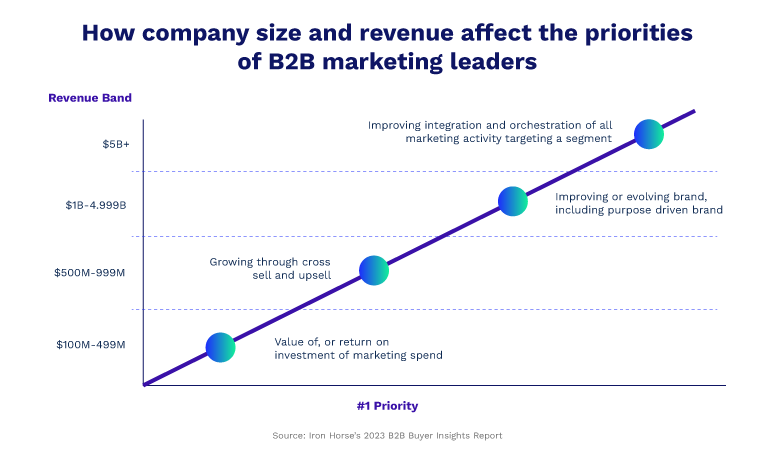Iron Horse’s 2023 Buyer Insights Report presents seven trends that reveal how B2B buyers discover, research and make decisions when buying technology solutions. One story that emerged—but didn’t make it into that report—involves a strong correlation between annual revenue and the priorities of marketing leaders. This data gives us a glimpse into how a company’s priorities change as it grows.

The top four priorities of B2B marketing leaders.
Companies in the $100M-$499M revenue band want to maximize their return on marketing spend. These companies often have limited resources and are typically growth-focused, which means they must prove the effectiveness of their strategies and ensure that every dollar spent generates a significant return in order to attract new logos.
- Companies in the $500M to $999M revenue band seek to grow through cross-selling and upselling. These organizations typically have established customers. Therefore, the priority shifts from acquiring new customers to maximizing the value of their existing customer base, from which a large portion of revenue comes.
- Companies in the $1B to $4.99B revenue band focus on evolving their brand. Usually, these organizations operate in a crowded marketplace with numerous competitors. They recognize the importance of creating a unique brand identity that sets them apart from their competitors so they can expand into new markets or target new customer segments.
- Companies in the $5B or more revenue band aim to improve integration and orchestration of all marketing activities. To scale, marketing leaders in these organizations must navigate competing priorities among multiple business units, product units and geographies. Improving integration and orchestration helps streamline complex marketing activities to help ensure consistent messaging and a coordinated approach across different channels and segments.
What does this mean for marketers?
When selling to marketing leaders, customize your messaging to meet the buyer’s highest priorities according to the size and revenue of their company. This understanding helps you highlight relevant product and service features, or position in a way that resonates with what your buyer cares about most. For example, a content lifecycle tool can be positioned as a cost-saving device for small companies by identifying low-use assets that don’t need to be refreshed. For larger companies, the same tool can be positioned as a means to support consistency in brand and messaging use.



